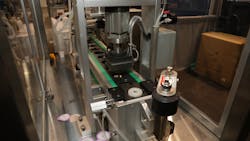Decoding automation: Essential considerations for process manufacturers revamping their systems
Automation is quickly becoming the answer for process manufacturers seeking greater proactivity, boosted uptime and a stronger ROI — especially amid COVID-19.
Key benefits include improving consistency and enabling continuous operation, thanks to equipment that uses precise movements to create a replicable result — without fail, and without ever stopping. Automation can also help to address ongoing challenges around labor shortages, filling gaps where needed and ensuring production does not falter.
Yet, the road to an automated system can be a daunting journey, as the addition of new technology comes with significant investments and a new production landscape to navigate. With the right insight and support, manufacturers can adopt automation with greater confidence and experience a more seamless transition.
Whether installing a single piece of equipment or swapping out an entire line, implementing automation is not always a plug-and-play scenario. Without the proper knowledge and preparation, manufacturers are likely to face a few blind spots and run into some issues as a result. Predicting where these issues may occur — and having guidance on the proper solution — is critical to a successful implementation.
Across industries, PMMI, The Association for Packaging and Processing Technologies, advises manufacturers to be aware of a few common challenges related to automation:
Issue: Miscommunication on the manufacturing line
Typically, manufacturers limit their automation planning groups to those heading design, such as engineers, and fail to bring in machine operators for their take on the new system. Unfortunately, poor communication — or a lack thereof — around the manufacturing line setup can cause costly bottlenecks once production is underway.
Solution: Engage employees at the right levels
From Day One of planning around production line changes, it is imperative to bring in the right team and involve everyone who touches the manufacturing environment: line operators, mechanics, technicians, etc. Employees on the front line, who will be in charge of running the equipment, will know how the system has to work and will be able to pinpoint potential red flags in design or setup. This is especially critical in the design phase, as once a system is installed and lights are on, the costs to fix any bugs are exponential.
Issue: Overcomplicated equipment designs
Manufacturers implementing automated systems sometimes opt for more costly, customized equipment when the off-the-shelf version is enough to properly execute the job both today and in the foreseeable future. This often occurs with automated technologies for secondary packaging, for which end users want to dictate the design of the internal workings of the equipment.
Solution: Stick to the basics
Start your planning process with a clear understanding of the types of equipment you need and why, based on your application area. Knowing your goals and what features and capabilities are going to make a difference in your specific production line will help inform your equipment design. It will also help set parameters around where to invest and where to avoid unnecessary sophistication and expenditures. These savings extend into areas such as troubleshooting and maintenance, as well, with more universal equipment likely to receive quick technical support and keep downtime to a minimum.
Issue: Information overload
Automated systems revolve around an exchange of information between machines — information that can reveal important findings around inefficiencies, maintenance needs and more. While exciting, the influx of data now available can make it difficult for manufacturers to not only pin down what metrics and insights are useful for production but to later interpret that information in a way that creates value.
Solution: Create a data strategy
The key to attacking the nebulous world of “big data” and the Industrial Internet of Things (IIoT) is to develop a roadmap for identifying what types of information your production line requires and how you will collect and interpret that data. Perhaps predicative maintenance is a top concern for your line, or you may prioritize the identification of manufacturing bottlenecks. Either way, an intelligent move into digitization is essential for successful data analysis, meaning that the strategy cannot be to collect data and simply “put it in the cloud” but to know exactly what measurements are necessary and how to use them to enhance production. Companies that have executed IIoT projects well have not done so by happenstance but by careful design.
Regardless of specific industry or application, manufacturers should approach automation with purpose and care. From planning to installation, it is important to ask questions and differentiate between an intriguing option and a real need. Where possible, consult with internal and external teams that can leverage expertise from all points in the production line and from all system perspectives.
The general rule to live by? Move forward with a “Ready, aim, fire” mindset in place of a “Fire! What did I hit?” attitude. A proactive, intentional strategy will preserve costs and headaches over time and ensure a more successful integration of automation.
As manufacturers and end-users continue to navigate questions around automation, the brand new live, web-based PACK EXPO Connects 2020 (November 9-13) ), produced by PMMI Media Group, will provide the same opportunities and insights the industry has relied on through the PACK EXPO portfolio of trade shows for more than 60 years. The event will serve as North America's resource for the most advanced packaging technologies across a wide range of industries and will facilitate exhibitor and attendee interaction through live chats, product and equipment demos, as well as engaging educational sessions.
More information and updates on the show are available at packexpoconnects.com.
Bryan Griffen is director, industry services, PMMI, The Association for Packaging and Processing Technologies.

